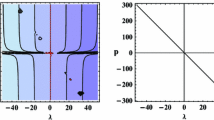Abstract
We construct the second variation Lagrangian for the Randall*Sundrum model with two branes, study its gauge invariance, and introduce and decouple the corresponding equations of motion. For the physical degrees of freedom in this model, we find the effective four-dimensional Lagrangians describing the massless graviton, massive gravitons, and the massless scalar radion. We show that the masses of these fields and their matter coupling constants are different on the different branes.
Similar content being viewed by others
REFERENCES
V. A. Rubakov and M. E. Shaposhnikov, Phys. Lett. B, 125, 136 (1983).
V. A. Rubakov and M. E. Shaposhnikov, Phys. Lett. B, 125, 139 (1983).
J. Polchinski, "TASI lectures on D-branes,” hep-th/9611050 (1996); E. Witten, Nucl. Phys. B, 471, 135 (1996); J. Lykken, Phys. Rev. D, 54, 3693 (1996);C. P. Bachas,"Lectures on D-branes," hep-th/9806199 (1998).
I. Antoniadis, "String and D-brane physics at low energy,” hep-th/0102202 (2001).
N. Arkan-Hamed, S. Dimopoulos, and G. Dvali, Phys. Lett. B, 429, 263 (1998).
L. Randall and R. Sundrum, Phys. Rev. Lett., 83, 3370 (1999).
L. Randall and R. Sundrum, Phys. Rev. Lett., 83, 4690 (1999).
V. A. Rubakov, Phys. Usp., 44, 871 (2001); hep-ph/0104152 (2001).
I. Ya. Aref'eva, M. G. Ivanov, W. Mück, K. S. Viswanathan, and I. V. Volovich, Nucl. Phys. B, 590, 273 (2000).
L. P. Grishchuk, A. N. Petrov, and A. D. Popova, Comm. Math. Phys., 94, 379 (1984).
Ch. Charmousis, R. Gregory, and V. Rubakov, Phys. Rev. D, 62, 067505 (2000).
N. Arkan-Hamed, S. Dimopoulos, and J. March-Russel, Phys. Rev. D, 63, 064020 (2001).
R. Sundrum, Phys. Rev. D, 59, 085010 (1999).
W. D. Goldberger and M. B. Wise, Phys. Lett. B, 475, 275 (2000).
C. Csáak, M. Graesser, L. Randall, and J. Terning, Phys. Rev. D, 62, 045015 (2000).
H. Davoudiasl, J. H. Hewett, and T. G. Rizzo, Phys. Rev. Lett., 84, 2080 (2000).
H. Davoudiasl, J. H. Hewett, and T. G. Rizzo, Phys. Rev. D, 63, 075004 (2001).
H. Bateman and A. Erdély, eds., Higher Transcendental Functions (Based on notes left by H. Bateman), Vol. 2, McGraw-Hill, New York (1953).
L. D. Landau and E. M. Lifshitz, Course of Theoretical Physics [in Russian ], Vol. 2, Classical Field Theory, Nauka, Moscow (1967); English transl., Pergamon, Oxford (dy1975).
B. Grinstein, D. R. Nolte, and W. Skiba, Phys. Rev. D, 63, 105005 (2001).
W. D. Goldberger and M. B. Wise, Phys. Rev. Lett., 83, 4922 (1999).
Author information
Authors and Affiliations
Rights and permissions
About this article
Cite this article
Boos, É.É., Volobuev, I.P., Kubyshin, Y.A. et al. Effective Lagrangians of the Randall–Sundrum Model. Theoretical and Mathematical Physics 131, 629–640 (2002). https://doi.org/10.1023/A:1015420730826
Issue Date:
DOI: https://doi.org/10.1023/A:1015420730826



